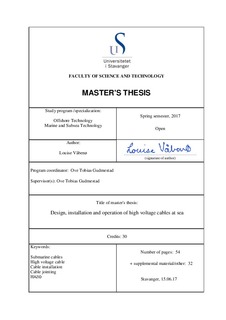| dc.description.abstract | Underwater cables have been connecting continents since the 1860s. Over time, the process of laying cables at sea has developed into a state-of-the-art operation. Now these operations are becoming more technologically advanced and it is possible to lay large diameter electric cables over large distances. One method is to lay cables in two or more lengths to have them jointed together mid-sea. A particular challenge will occur in case an unplanned splicing will be necessary. In this thesis, we will explore the design criteria for such cables and the procedures and challenges of installation. Furthermore, the effects of how dynamic motions of the vessel and sea influence the situation in deep water will be explored.
The OrcaFlex software will be used to simulate and analyze the effects of waves on vessel motion, and how this may affect the cable during a jointing operation of two cables at different water depths. The effects of current forces on the cable are to be analyzed and how the cable reacts to both current and wave forces. This analysis method can assist in determining the weather criteria for a jointing operation to prevent excessive bending, compression or fatigue damage in the cable.
When installing a cable in an area with currents, one needs to take into account the direction of the currents relative to the cable, as tension and bending of the cable are highly affected by the direction and strength of the current.
From the OrcaFlex analysis, one can see that vessel motion due to waves are more critical to the cable with respect to fatigue damage in shallow water (100 m) than in deep water (1200 m). The residual bottom tension in the cable at the touch down point is, however, more sensitive to the vessel motion at deep water than in shallow water.
In areas with waves and currents, a current approaching the cable at 0 degrees will decrease the critical parameters. The bottom tension is less affected by the vessel motion and the cable will experience less bending cycles over the laying wheel. With a large current approaching at 180 degrees (i.e. toward the vessel), the bending of the cable increases and hence the cable may experience fatigue damage sooner. The bottom tension in the cable will become more sensitive to vessel motions in this situation and the risk of loops developing will increase as tension decreases.
By changing the location of the laying wheel, one can improve the situation. Placing the wheel closer to the center of the stern will reduce the effect of vessel motion on cable tension. The cyclic bending of the cable is, however, less affected by changing the laying wheel location.
A HAZID carried out for cable installation, shows that there are many risks and hazardous events that may occur during the operation in connection to the cables integrity. Handling these risks early may reduce both their probability of occurring and the related consequences.
One finding in the analysis is that there are different requirements for laying cable and jointing operations. The suitable sea states for jointing are more limited than for laying. When vessel and cable are standing still, all bending occurs at the same place in the cable, resulting in increased risk of fatigue damage, hence it is necessary with a calmer sea state for this kind of operation.
Future work might emphasis on developing quick connectors to quickly join cable ends offshore. Reference is here made to the offshore oil and gas industry’s underwater connectors. | nb_NO |
